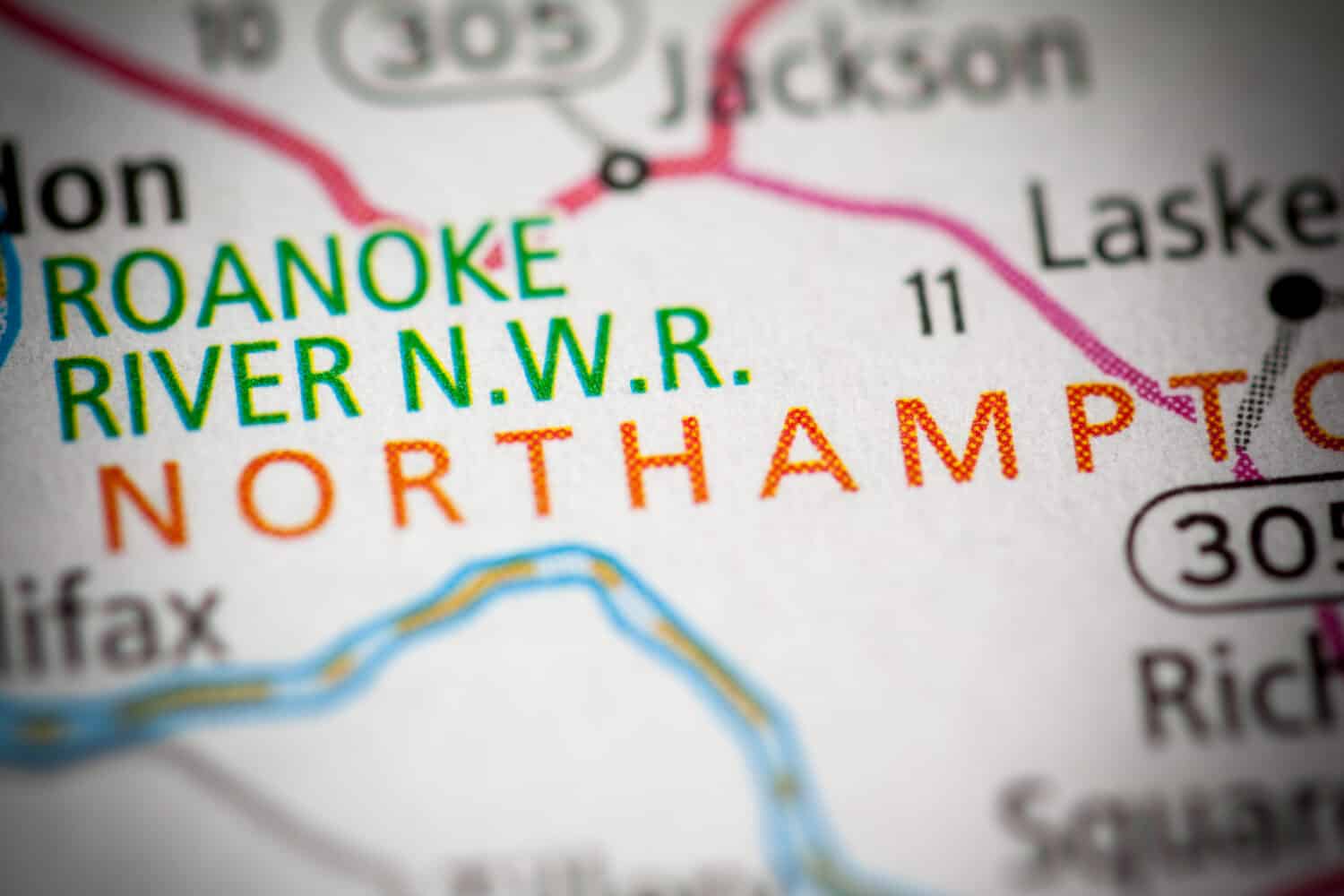Did you know that in 2021, over 10 million people lived in the southern coastal state of North Carolina? In fact, 2022 U.S. Census estimates placed over 10.7 million residents as inhabiting the “tar heel state.” North Carolina is one of the fastest-growing states in the country. In recent years, the state has moved up the rankings to join the rankings as one of the top 10 fastest-growing states in the U.S. With North Carolina’s Brunswick County, Cabarrus County, Currituck County, Wake County, and Durham County taking the lead as among the counties with the greatest gains in population increases (by percentage) in recent years, North Carolina will likely continue to see enormous growth in the days ahead. There are eight fast-growing counties in North Carolina that you should pay attention to.
However, not everywhere in the state is experiencing the same kind of boom. This article introduces you to some of the fastest-shrinking counties in North Carolina. Let’s learn together about some of the places where the population has declined in recent years.

Population Changes in North Carolina
As a whole, North Carolina’s population has been booming. Many current North Carolina residents are not originally from the state or even the southeast at all – in fact, many people have come from northern urban centers such as New York City or Chicago, or from west coast cities such as Los Angeles or San Francisco. Some have left looking for more space to spread out, a slower pace of life, or simply warmer weather. Over the last 10 years, thousands of people have flocked to cities in North Carolina like Durham, Chapel Hill, and Raleigh, or found seasonal homes on the coast near gorgeous North Carolina beaches. However, census data shows that this population change is not impacting all parts of North Carolina equally – some counties have seen dramatic population declines.

Durham, North Carolina, is one of the fastest-growing cities in a rapidly expanding part of the state.
©Sean Pavone/Shutterstock.com
What is causing the declining populations? Some experts cite factors such as restrictive policies that limit immigration, declining fertility rates, aging populations in the U.S. as a whole and North Carolina specifically, deaths due to drug overdoses, and other health factors such as the COVID-19 pandemic.
Some of the fastest-shrinking counties in North Carolina may be experiencing some of these population factors first-hand. Before we discuss that, here is an overview of some of the areas that have seen the most growth.

Many of the young people from North Carolina’s rural counties are moving to cities like Raleigh, for school, work, or entertainment opportunities.
©iStock.com/Mark Howard
List of the Top Fastest Growing Counties in North Carolina
Here are some of the counties in North Carolina that had some of the great population gains in recent years:
- Brunswick County
- Cabarrus County
- Currituck County
- Wake County
- Durham County
- Franklin County
- Johnston County
- Pender County
It is certainly worth taking the time to learn more about these fast-growing parts of North Carolina. However, that is not what this article is about. Let’s look at some of the fastest-shrinking counties in North Carolina.
List of the Top Counties in North Carolina with Declining Populations
These are the counties in North Carolina that have seen the greatest population declines as indicated by the change from the 2010 census data to the 2020 census data:
- Tyrrell County: -26.4%
- Northampton County: -20.9%
- Hyde County: -21%
- Anson County: -18.2%
- Washington County: -16.8%
A Closer Look at 5 of the Fastest-Shrinking Counties in North Carolina
1. Tyrrell County

The population in Tyrrell County, North Carolina fell 26.4% from 2010 to 2020.
©HarmonyReignPope / CC BY-SA 3.0 – License
Tyrrell County, North Carolina, saw the greatest population decline in the state from 2010 to 2020. During this time, Tyrrell County’s population declined by an incredible 26.4%! This rural county is the least populous in the state of North Carolina. Known as “nature’s buffer zone,” Tyrrell County sits between North Carolina’s urban mainland and the popular ocean-side destination called the Outer Banks. Since its founding in 1729, residents of Tyrrell County have born witness to incredible wildlife and spectacular natural wonders. This remote county has only just over 3,000 residents. However, it has many other wildlife inhabitants – from red wolves to black bears and bald eagles.
Sadly, Tyrrell County is also seeing a decline in its population that has been continuing for more than a decade. A combination of factors, including declining birth rates among the current population, are contributing to the loss of residents.
Tyrrell’s county seat is Columbia. Other communities in the county include Gum Neck, Kilkenny, Fort Landing, Frying Pan Landing, Newfoundland, and Woodley. In 2021, the St. Louis Fed estimated the median household income for families in Tyrell County, North Carolina to be $39,970 a year. As of June 2023, Realtor.com reported that the median single-family home in Tyrell County, North Carolina, was $165,000.
Attractions and Wildlife in Tyrrell County

Tyrrell County, North Carolina, is home to the Red Wolf Education and Health Care Facility, which is working to save the red wolf population.
©Matt Cuda/Shutterstock.com
Known for its unique ecology and wildlife preservation, animal lovers are sure to adore Tyrrell County’s unique opportunities to learn about and see native and endangered species. For example, be sure to visit the vast Pocosin Lakes National Wildlife Refuge, which has 110,000 acres of land serving as home to black bears and many other creatures. You might also want to learn about the Red Wolf Education and Health Care Facility, which is working to save the only remaining red wolf population in the world.
Tyrrell County has many water- and land-based ecotourism opportunities. From the Scuppernong to the Alligator River and Lake Phelps to the Albemarle Sound, Tyrrell County’s waterways are important features of the local habitats.
2. Northampton County

Northampton County, North Carolina’s county seat is Jackson and its largest town is Gaston.
©SevenMaps/Shutterstock.com
Next on the list of fastest-shrinking counties in North Carolina is Northampton County, a productive agricultural region with numerous farms in northeastern North Carolina. Northampton County’s county seat is Jackson and its largest town is Gaston. The other towns in the county include Rich Square, Garysburg, Seaburg, Conway, Woodland, Lasker, Severn, and Milwaukee. With a population of just over 17,000 in 2021, the county’s population has been shrinking for a long time. Between 2010 and 2021, the county shrank 2.2% each year on average. Between 2019 and 2020, the population dropped by 10.65!
However, Northampton County’s population decline dates back to far before 2010. In fact, this area has been declining since the 1960s. Sadly, many of the area’s young people have fled to bigger cities and other parts of the state. They are leaving behind declining regions, where a lack of jobs and opportunities are causing even the most faithful residents to consider leaving.
In 2020, the median household income in Northampton County was $38,969. As of June 2023, Realtor.com reported that the median single-family home cost $135,000.
Attractions and Wildlife in Northampton County
This rural part of the state claims to display the time-honored southern traditions while welcoming visitors with the “talent, vigor, and spirit of the New South.” Visitors and residents alike can enjoy the Roanoke River, where you can spot black bears, river otters, white-tail deer, beavers, minks, and turkeys. You should also watch out for the 200 birds that nest in or pass through the area.
The Upper Roanoke River Wetlands Game Land offers over 10,000 acres spread across Bertie, Halifax, and Northampton counties. The area boasts that it has some of the best hunting and fishing opportunities in the region. In fact, Northampton County is a prime destination for those who want to hunt or simply watch white-tail deer or turkey, or fish for strippers in Roanoke River.
If that’s not for you, you can visit the towns of Jackson, Woodland, or Seaboard to enjoy some local cuisine at one of the few small, locally-owned restaurants and businesses.
Hyde County

Hyde County is home to Ocracoke, where a lighthouse was built to guide shops through the Ocracoke Inlet and into the Pamlico Sound.
©Chansak Joe/Shutterstock.com
Hyde County, North Carolina, had a population of 4,589 in 2020, making it the second least populous county in the state. However, it is the second-largest by land area! Like Tyrrell County, Hyde County is in the east of North Carolina, near the coast. Within Hyde County there are five townships, six unincorporated communities, and four census-designated places–including Swan Quarter, the county seat, and Ocracoke, the largest community.
In June 2023, the median cost of a single-family home in Hyde County was $575,000. This signals that the home prices in the area are up significantly year-over-year. The median household income in 2021 was $48,577.
Attractions and Wildlife in Hyde County
Though Hyde County is one of the most rural parts of the state, Ocracoke Island is part of the increasingly popular Outer Banks area. Visitors to Hyde County may enjoy visiting the Ocracoke Lighthouse, going hunting or fishing, taking in the county’s history, or going to one of the National Wildlife Refuges within the county limits.
In fact, Hyde County remains one of the most wild and undisturbed parts of the entire state. While agriculture, forest, and small towns are prominent across Eastern North Carolina, the scarcity of major highways and lack of major development mean that Hyde County is still a sanctuary for the region’s wildlife. If you want to go shopping, eat at well-known restaurants, or experience a local’s day-in-the-life, Hyde County does not have much to offer outside of the coastal tourism and ecotourism industry. However, if you are seeking a haven for nature lovers, this might be the place for you to visit or even move to!
Anson County

Anson County, North Carolina, sits on the southern border of the state, bordering South Carolina.
©SevenMaps/Shutterstock.com
Anson County, North Carolina, saw its population decline from 26,947 in 2010 to 22,055 in 2020. This loss of nearly 5,000 people, or 18.2% of the population, was a significant decline that the county has not experienced the likes of for decades –or since 1790, according to the County Commissioner!
Unlike some of the other areas named on this list, Anson County is not in the eastern part of North Carolina. Rather, Anson County sits on the southern border of the state, just above South Carolina, in North Carolina’s western half. With a population of around 22,000, Anson County is still on the smaller side – but this town is proud of its outdoor recreation opportunities, culture, business, and community life. The county seat is Wadesboro. The other cities in the county include Polkton, Lilesville, Morven, Peachland, Ansonville, and McFarlan.
In June 2023, the median cost of a single-family home in Anson County was reported to be $265,100. The median household income in the county was $39,862 in 2021.
Attractions and Wildlife in Anson County
Anson County offers residents and visitors alike plenty of opportunities to enjoy the outdoors or get involved with local culture. The Ansonia Theater is a community theater that puts on plays. The Anson County Arts Council sponsors all manner of artistic and musical events in the community. Members of the Anson County Historical Society preserve local history and genealogical records. On top of that, the area has rich opportunities to get outside and enjoy nature.
As one example of that, across nearly 8,500 acres in Anson and Richmond counties stretches the Pee Dee National Wildlife Refuge. The refuge has a diverse group of wildlife species that call it home. There are over 180 bird species, 49 amphibian and reptile species, and 20 fish species in the area. You should also watch out for 28 different mammals, including bobcats, raccoons, opossums, white-tail deer, and many others. The area is also home to many different nature preserves, shooting and hunting preserves, and parks with lakes and mountains that attract outdoor adventurers of all types.
Washington County

Somerset Place is an unusual plantation located in Creswell, North Carolina, inside Washington County.
©Jeffrey M. Frank/Shutterstock.com
Washington County, North Carolina is a rural county next to Tyrrell County in the part of the state. As of the 2020 census, the county only had a small population of about 11,000 people, and the area declined significantly from the 2010 census to the 2020 census. Projections show that further population decline is imminent. For some of the reasons also affecting other counties in North Carolina, the area is experiencing a consistently-shrinking population and is losing residents every year.
The county seat and largest town is Plymouth. The nearby towns of Roper and Creswell; the unincorporated communities of Lake Phelps, Mackeys, and Pea Ridge; and the Plymouth, Lees Mill, Scuppernong, and Skinnersville townships are all part of the area’s scenic landscape of beautiful farmland, forests, and waterways.
In 2021, the median household income of Washington County was $32,937. According to Realtor.com, the cost of a single-family home in the area in June 2023 was $189,000 and trending downward.
Attractions and Wildlife in Washington County
The county sells itself with the motto of “Washington County, North Carolina: where traffic ends and adventure begins.” The area has a quaint historic downtown, natural beaches, and wildlife refuges preserving the habitat of animals such as the American black bear. It has also won the accolade of being on the list of North Carolina counties with the lowest cost of living.
The Somerset Place Plantation is also part of the local history. Originally, this plantation included over 100,000 acres of forested marshland. The historic building still takes visitors back to 19th-century life. Visiting could be a great way to learn more about the past of the area, the history of enslavement, and the plants and animals that still live on the plantation grounds.
Summary of the 5 Fastest-Shrinking Counties in North Carolina
| County | Percentage Loss | |
|---|---|---|
| 1 | Tyrrell County | -26.4% |
| 2 | Northampton County | -20.9% |
| 3 | Hyde County | -21% |
| 4 | Anson County | -18.2% |
| 5 | Washington County | -16.8% |
The photo featured at the top of this post is © PredragLasica/Shutterstock.com
Thank you for reading! Have some feedback for us? Contact the AZ Animals editorial team.






